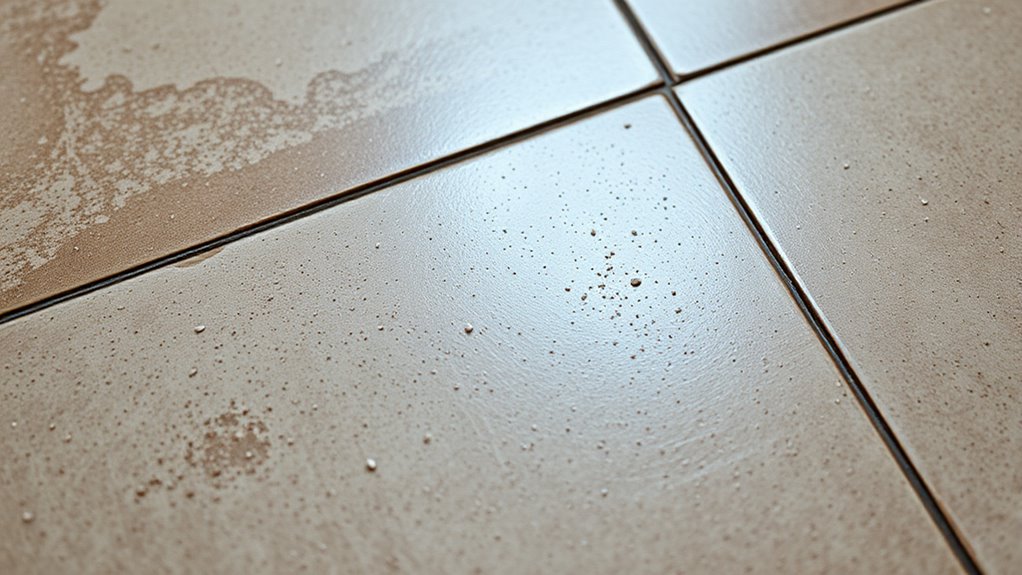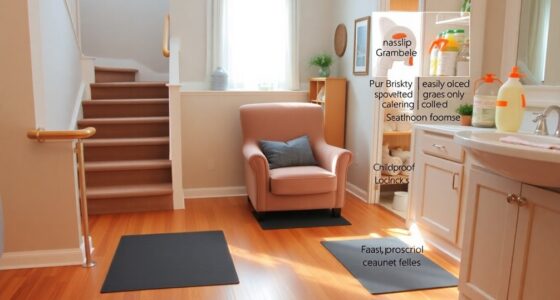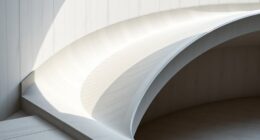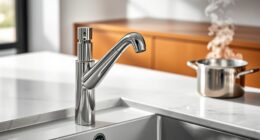To make old tiles safe again, you can apply non-slip treatments like coatings or sealants that increase traction without changing their look. These products bond to the tile surface and provide instant grip, ideal for wet or slippery areas. You might also consider textured adhesives or films for quick fixes or even etching the tiles to create a rougher surface. To learn more about the best options for your situation, keep exploring your choices.
Key Takeaways
- Apply non-slip coatings or treatments that bond to existing tiles to instantly increase traction without altering appearance.
- Use textured adhesives or films for quick, removable traction solutions, especially in high-moisture areas.
- Consider light sanding or etching to create a rougher surface for enhanced slip resistance, suitable for durable, long-term safety.
- Ensure thorough cleaning before applying any treatment to maximize adhesion and effectiveness.
- Regular maintenance and reapplication of non-slip products help maintain safety on aging or slick tiles.

Slippery tiles can pose a serious safety risk, especially in high-traffic or wet areas. If you’ve noticed your old tiles becoming slick and hazardous, you’re not alone. Over time, smooth surfaces can lose their grip due to dirt accumulation, wear, or even the type of finish used initially. Fortunately, there are effective non-slip treatments that can restore safety without the need for complete replacement. These treatments are designed to enhance traction, making your tiles safer to walk on, regardless of their age or condition.
One of the simplest options is applying a non-slip coating or treatment specifically formulated for tiles. These products are usually transparent or come in neutral colors, so they don’t alter the appearance of your flooring. When you apply the coating, it bonds to the tile surface, creating a textured layer that increases friction. The process is straightforward: clean the tiles thoroughly to remove dirt, grease, or any previous sealants, then follow the manufacturer’s instructions to evenly apply the treatment. After it dries, you’ll notice an immediate improvement in grip. The best part? You don’t have to replace your tiles or endure major renovations.
Applying a clear, textured non-slip coating can instantly improve tile safety without renovation.
Another popular method involves using a non-slip adhesive or film. These are thin, textured strips or sheets that you can cut to size and stick directly onto the tiles. They work well in areas prone to water spills, such as kitchens or bathrooms, because they provide instant traction. Plus, they’re removable, so if you move or want to change your decor, you can peel them off without damaging the tiles. Installing these films is quick and simple—just ensure the surface is clean and dry before application for the best adhesion. They also work well for temporary solutions or rental properties where you might not want to commit to permanent changes.
For a more permanent fix, some homeowners opt for etching or abrading the tile surface. This involves lightly sanding or grinding the tiles to create a rougher texture. While effective, this method requires more effort and care, as it can alter the appearance of your tiles and may need professional assistance to avoid damage. It’s best suited for those comfortable with DIY projects or for professional installation. Additionally, understanding the risks associated with improper treatment can help you choose the safest and most effective method for your situation.
No matter which method you choose, the goal remains the same: to make your old tiles safe again. Taking these steps not only helps prevent slips and falls but also extends the life of your flooring. It’s a cost-effective way to improve safety without the hassle of tearing out and replacing tiles entirely. With the right treatment, you can enjoy the look of your existing tiles while ensuring they’re slip-resistant and secure for everyone who walks on them.
Frequently Asked Questions
How Long Does Non-Slip Treatment Last Before Reapplication?
The non-slip treatment typically lasts between one to three years before needing reapplication. Factors like foot traffic, cleaning routines, and environmental exposure can affect its longevity. You should regularly inspect your tiles for signs of wear or slipperiness. When you notice the surface becoming less effective or shiny patches appearing, it’s time to reapply the treatment to maintain safety and slip resistance. Proper maintenance helps extend the treatment’s lifespan.
Are Non-Slip Treatments Suitable for Outdoor Tiles Exposed to Weather?
You’ll be glad to know that non-slip treatments suit outdoor tiles exposed to weather, but they do require maintenance. Since outdoor conditions like rain, sun, and temperature fluctuations impact their durability, you should expect reapplication every 1 to 3 years for maximum safety. Regular inspections help catch wear early, ensuring your outdoor space remains slip-resistant and safe for everyone, rain or shine.
Can Non-Slip Coatings Be Applied Over Existing Tiles Without Removal?
Yes, you can apply non-slip coatings over existing tiles without removal, but preparation is key. Clean the surface thoroughly to remove dirt, grease, and loose grout, then sand or etch the tiles to guarantee proper adhesion. Follow the manufacturer’s instructions carefully for application and curing times. Doing this will ensure the coating bonds well and provides the slip-resistant surface you need, without the hassle of removing the old tiles.
Do Non-Slip Treatments Alter the Appearance or Color of Tiles?
Non-slip treatments are designed to be unobtrusive, so they usually don’t substantially change the appearance or color of your tiles. You might notice a slight matte finish or texture, but the original color and pattern typically remain visible. If you’re concerned about maintaining your tiles’ aesthetic, choose a treatment specifically formulated to preserve their look, and consider testing a small area first to see how it affects the appearance.
Are Non-Slip Treatments Safe for Homes With Children or Pets?
Over 70% of household accidents happen on slippery surfaces, so non-slip treatments are a smart choice. They’re generally safe for homes with children and pets when applied correctly, as most are non-toxic and designed to prevent slips without harmful chemicals. Just make certain you choose a reputable product, follow the manufacturer’s instructions, and allow proper curing time to keep your family safe and your tiles looking great.
Conclusion
By choosing the right non-slip treatments, you’re not just restoring safety—you’re gently embracing a renewed confidence in your space. These solutions subtly remind us that even the oldest tiles can regain their grace and purpose, quietly encouraging caution and care. With a little effort, you’ll find that your floors can continue to serve you well, offering peace of mind without the need for dramatic change. Sometimes, a gentle touch is all it takes to keep things steady.









